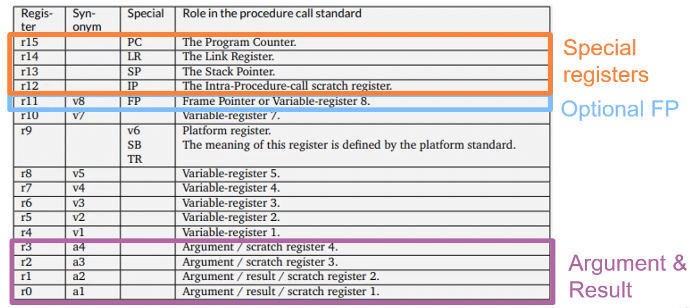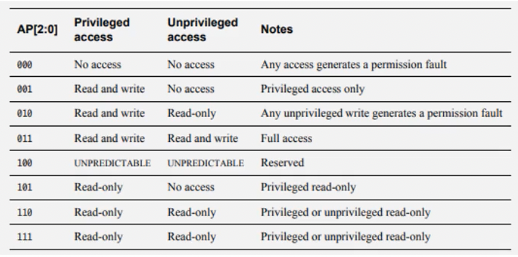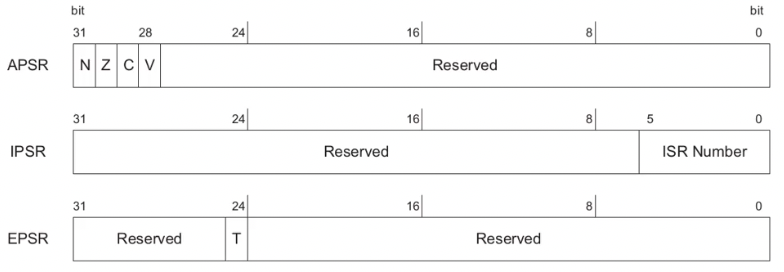Hardware security
Table of Contents
Exploitation for embedded systems
Typical embedded systems vulnerabilities:
- weak access control/authentication
- insecure config
- vulnerable web interfaces
- improper use of cryptography
- programming errors:
- can easily lead to buffer overflows, memory corruption
- classic defenses (ASLR, canaries..) may not be present
ARM architecture
32-bit (“aarch32”)
- 32 bit regs and address space
- little/big endian
- 32-bit fixed-width instructions, 16-bit with Thumb instruction set
- Thumb instruction set:
- 15-bit encoding for improved code density
- different processor states: “ARM” and “Thumb”, switched via
bxandblxinstruction
64-bit (“aarch64”)
- new instruction set, 64-bit regs and address space, 32-bit instruction length
- user-space compatible with aarch32
Application binary interface: Procedure Call Standard for the ARM Architecture (AAPCS)

ARM Linux system calls:
- arguments in r0-r6
- return value r0
- EABI: system call via
svc #0instruction with call number in r7 - OABI: system call via
swi NRinstruction- (
swiandsvcare the same instruction)
- (
ARMv6-M (Cortex-M0+)
Thumb-2, so classic 32-bit ARM not supported. Has a built-in interrupt controller. Optional privileged/unprivileged and MPU (memory protection unit) support, both present on STM32G0B1RET6 (the board we have).
Protected Memory System Architecture (PMSAv6):
- provides memory protection unit (MPU)
- separates flat address space into regions, smallest size 32 byte
- implementation-dependent number of regions
- requires privileged/unprivileged extension
- can be configured via MMIO
- provides access permissions and “execute never” (XN) bit

Nested Vector Interrupt Controller (NVIC)
- interrupts can occur (and be served) while an interrupt is already being handled
- vector set up via VTOR
- up to 32 external interrupts, 6 predefined exceptions
xPSR: combined program status register:
- application program status register (APSR): flags
- interrupt program status register (IPSR): exception number
- execution program status register (EPSR): thumb-bit (always 1)

Assembly:
- arithmetic:
MNEMONIC{s} Rdest, Rsrc1, Rsrc2(Rsrc2can also be#imm)- S-suffix updates condition flags, optional for ADD/SUB but mandatory for other arithmetic
- examples:
ADD r0, r1, r2:r0 = r1 + r2EORS r0, r0, r0:r0 = r0 XOR r0, updating flagsSUBS r3, r4, #8:r3 = r4 - 8, updating flags
MOV: can only mov to register, from register/immediateMOVTmoves immediate into top halfwordMVNmoves negative (logical ones’ complement)
PUSH- only registers
- r0 to r12 and lr
- example:
PUSH {r0, lr}
POP- only registers
- r0 to r12 and pc, or r0 to r12 and lr
- examples:
POP {pc},POP {r0-r6, lr}
- load/store:
LDR,STRMNEMONIC Rdst, [Rsrc, #offset](#offsetcan also be register)- examples:
LDR r0, [pc, #16]:r0 = *(pc+16)STR r0, [r3, #0]:*r3 = r0
- branches:
B: branch relative topc, allowscsuffix for conditionalBX(branch and exchange): branch via register and exchange instruction set- “exchange instruction set” means to switch between THUMB and ARM mode
- information of mode is stored in LSB of address
- this works because in ARM, instructions always aligned on 2-byte or 4-byte granularity
- ARMv6-M is Thumb-2 only, so all addresses need LSB set to 1
BLX(branch with link and exchange): setlrand branch relative topcor via registerBL(branch with link): sets link register and branches relative topc, like acall
Exploitation techniques
32-byte ARM usually has null bytes, but if you switch to thumb mode, instruction set compression makes null bytes unlikely:
add r3, pc, #1
bx r3
Example shellcode (from shell-storm):
add r3, pc, #1 // switch to thumb mode
bx r3
mov r0, pc // prepare arguments
adds r0, #8
subs r1, r1, r1 // r1 = 0
subs r2, r2, r2 // r2 = 0
movs r7, #11 // set syscall number
svc 1 // execute syscall
str r7, [r5, #32] // set up data: /bin/sh\0
ldr r1, [r5, #100]
strb r7, [r5, #12]
lsls r0, r5, #1
ROP on ARM:
- if XN memory, or no OS with system call abstraction
- strategy: overwrite stack with attacker-controlled data, chain “gadgets” to form meaningful program
- usually fewer gadgets than x86, e.g.
pop {pc}is much less common thanret - don’t forget about Thumb-bit – faults if set wrongly
Heap exploitation:
- implementations are application/device specific
- usually fewer consistency checks than on desktop
- often need reverse engineering heap implementation
- might be on vendor-provided toolchain though
Interrupt oriented programming:
- interrupts push SR+PC onto stack, interrupts are nestable, and ROM resides below RAM in memory
- so, stack growing exploit:
- nest interrupts until RAM exceeded
- stack grows into ROM
- unable to write SR+PC, so subsequent return from IRQ will use value from ROM